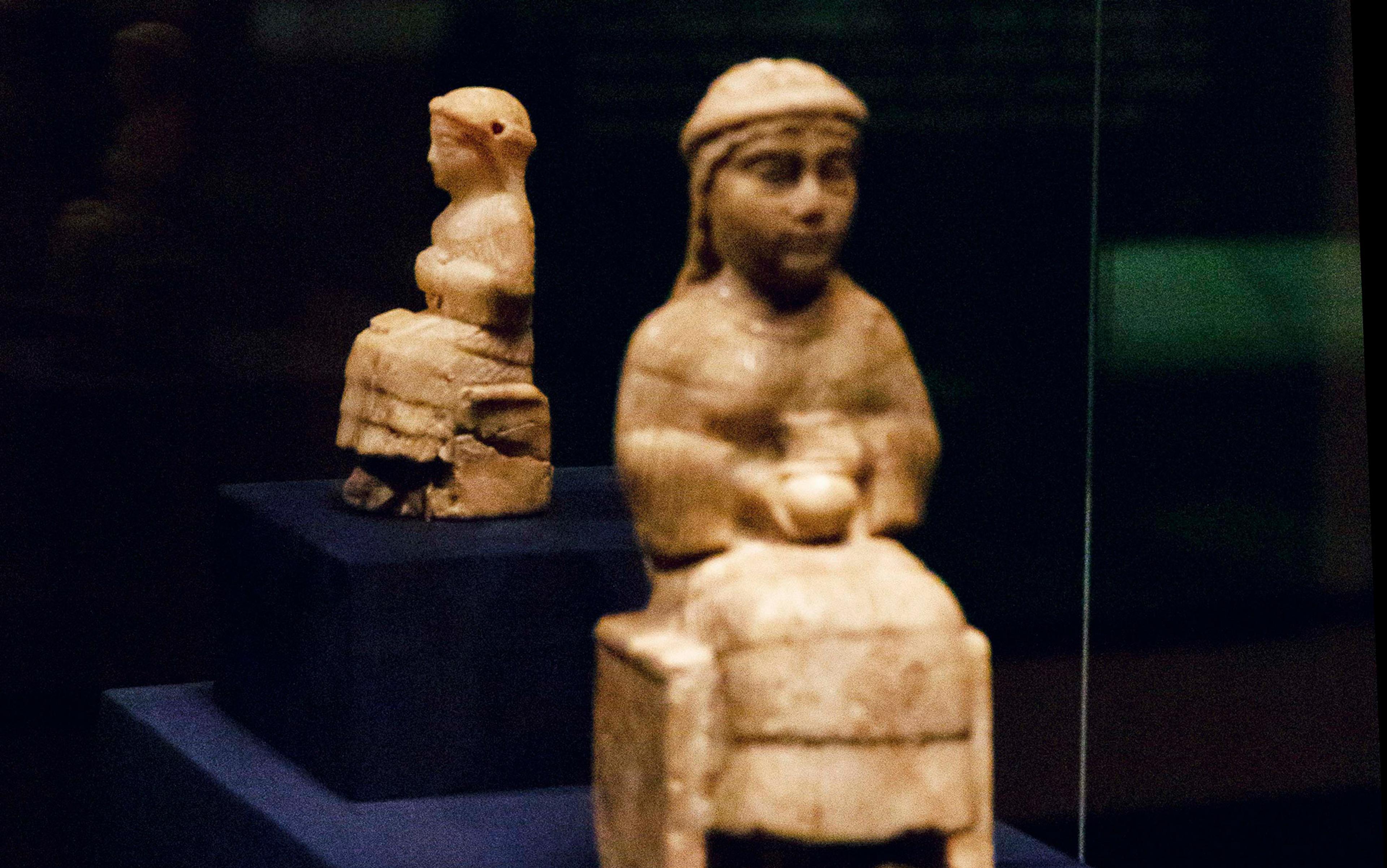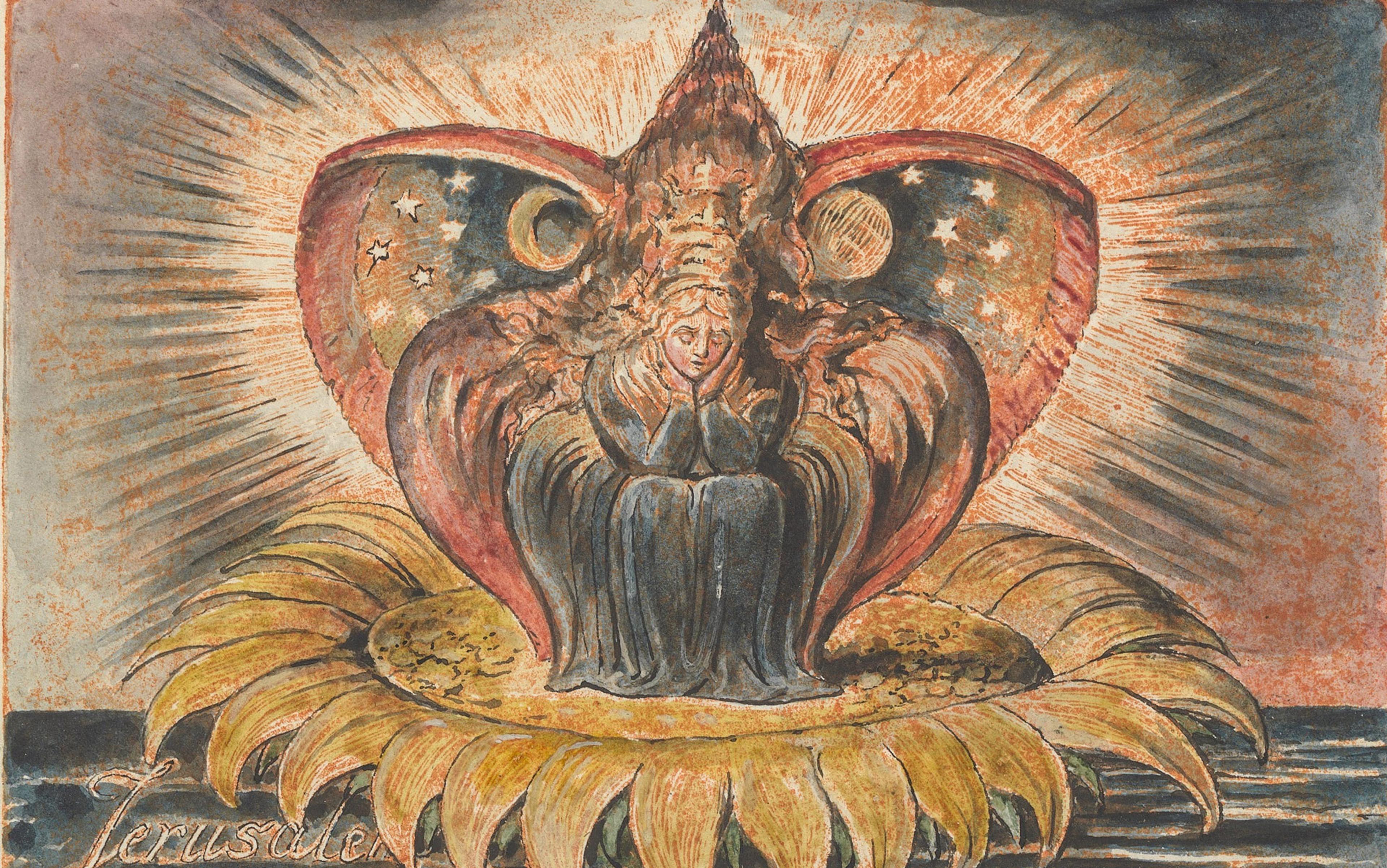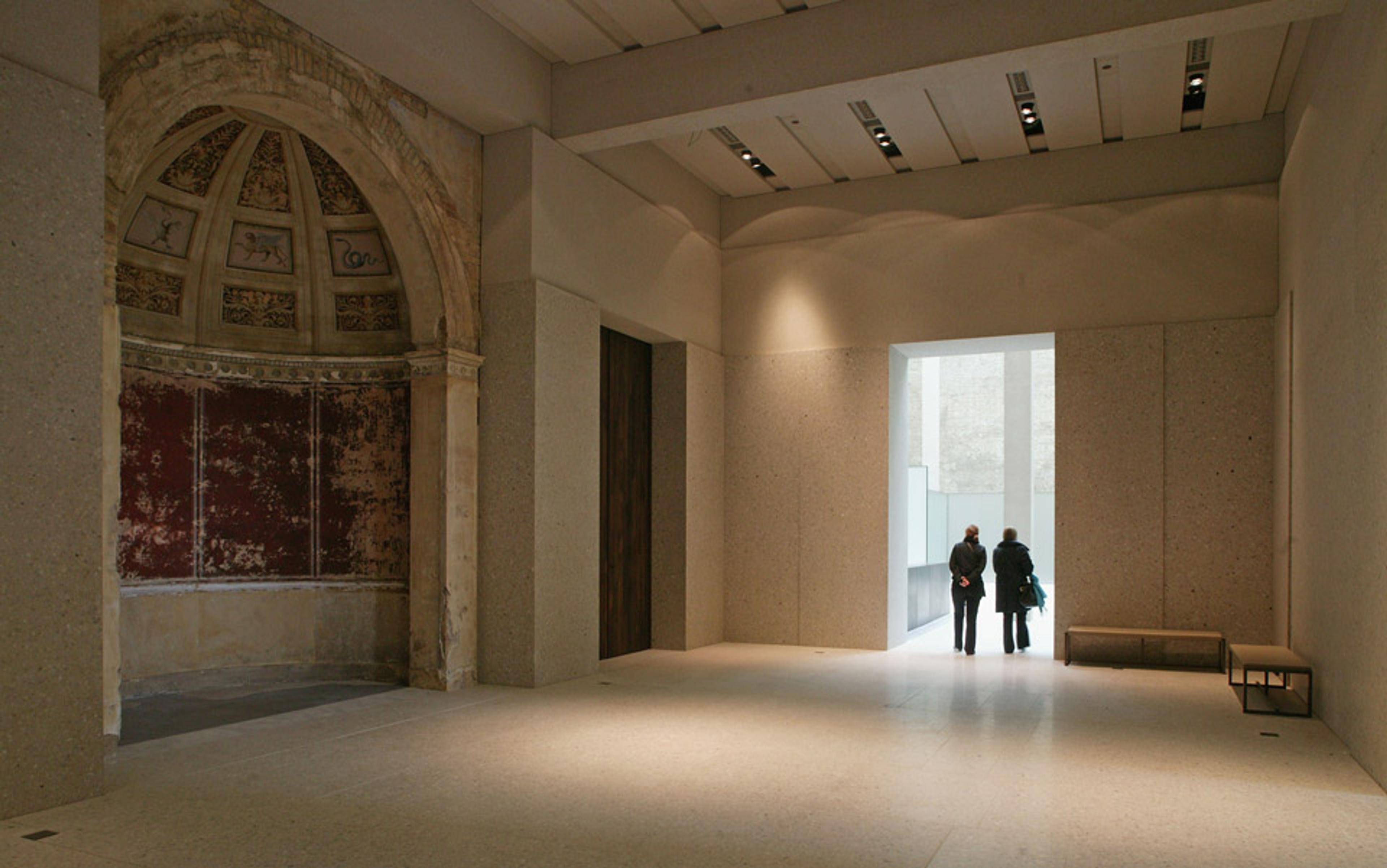About 4,200 years ago, the area we now call southern Iraq was rocked by revolts. The once-independent Sumerian city states had been brought under one rule by the legendary king Sargon of Akkad. Over the course of what modern historians call the Old Akkadian period, the reign of Sargon and his successors reshaped the newly conquered cities in countless ways: old nobles were demoted and new men brought to power, old enemies were defeated and new standards of statecraft imposed. The Sumerian world grew much bigger and richer, but also more unstable. Discontent with the new empire festered, provoking a steady stream of uprisings as the cities attempted to regain their independence.
One such revolt is depicted in a fascinating poem known as ‘The Exaltation of Inana’. Besides being a poetic masterpiece in its own right, ‘The Exaltation’ bears the distinction of being the first known work of literature that was attributed to an author whom we can identify in the historical record, rather than to an anonymous tradition or a fictional narrator. The narrator of the poem is Enheduana, the high priestess of the city of Ur and the daughter of Sargon. According to ‘The Exaltation’, she was cast into exile by one of the many revolts that plagued the Old Akkadian Empire.
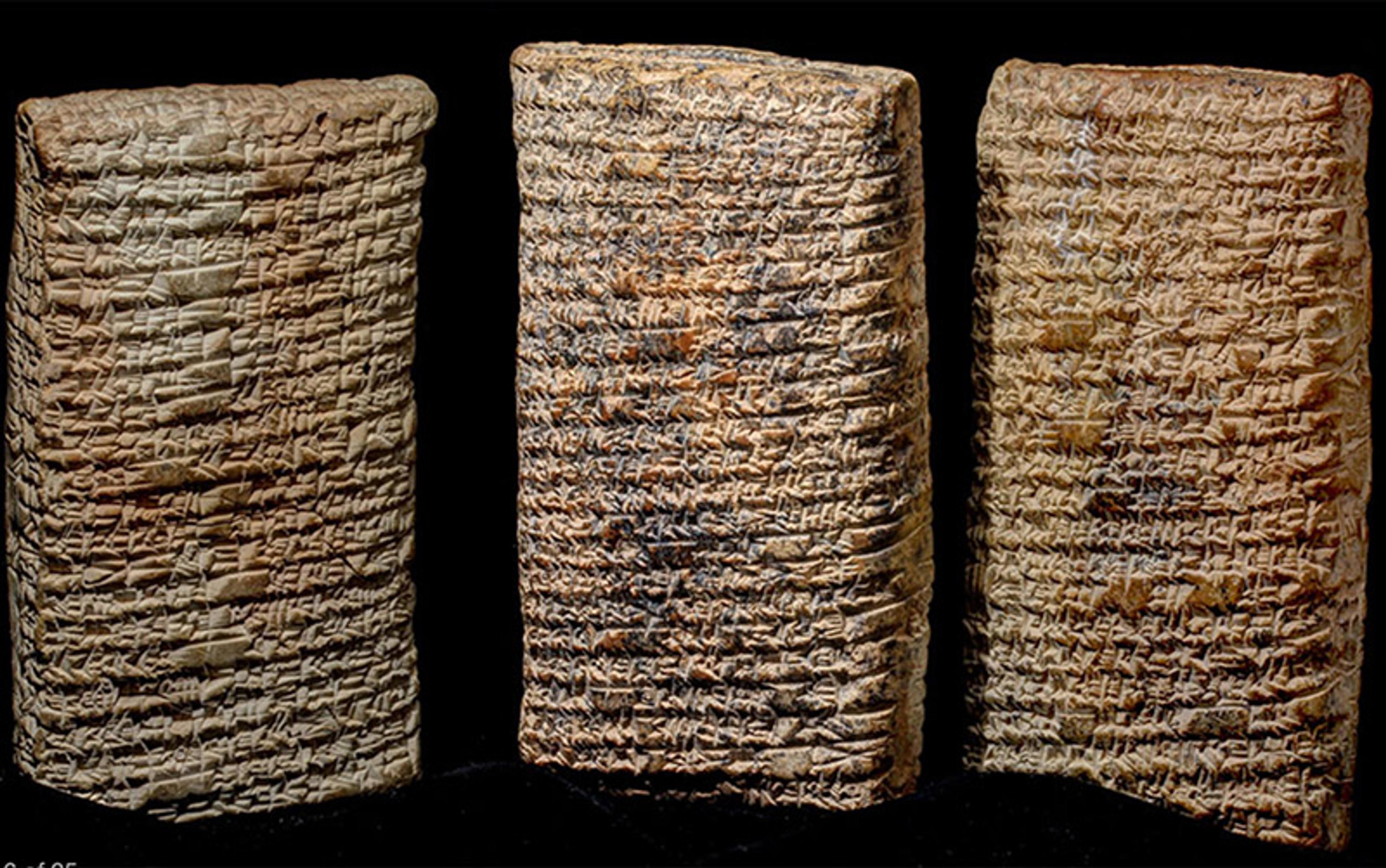
Tablets inscribed with The Exaltation of Inana in three parts. Old Babylonian period, c1750 BCE. Courtesy of the Yale Babylonian Collection
We do not know for sure whether the poem was written by the historical Enheduana herself, as a literary retelling of a real event, or by a later poet writing in her name, in the ancient version of a historical fiction that was meant to celebrate the famous high priestess. What we do know is that the poem conveys a sense of what it would have been like to live through a period of profound turbulence, whether as a personal account or an echo preserved in the cultural memory of later periods.
That is one reason why the works attributed to Enheduana – which, besides ‘The Exaltation’, comprise four other poems – continue to speak to us, millennia after their composition. As the world grows increasingly unstable, we have much to learn from this ancient priestess. The poems do not merely register the reality of an historic upheaval – they go one step further by turning that instability into a cosmic insight, an occasion to reflect on what the world is really like. They contain, compressed within their often-cryptic verses, the germ of an ancient philosophy of change.
If the poems seek to turn radical change from a transient political phenomenon into a universal principle, they do so primarily by exalting the goddess Inana, better known by her Babylonian and Assyrian name Ishtar. Two of the poems attributed to Enheduana, ‘The Exaltation’ and ‘The Hymn to Inana’, seek to elevate Inana to the head of the Sumerian pantheon, eclipsing the older male gods, Enlil and An, who rule the cosmos according to most other Sumerian texts.
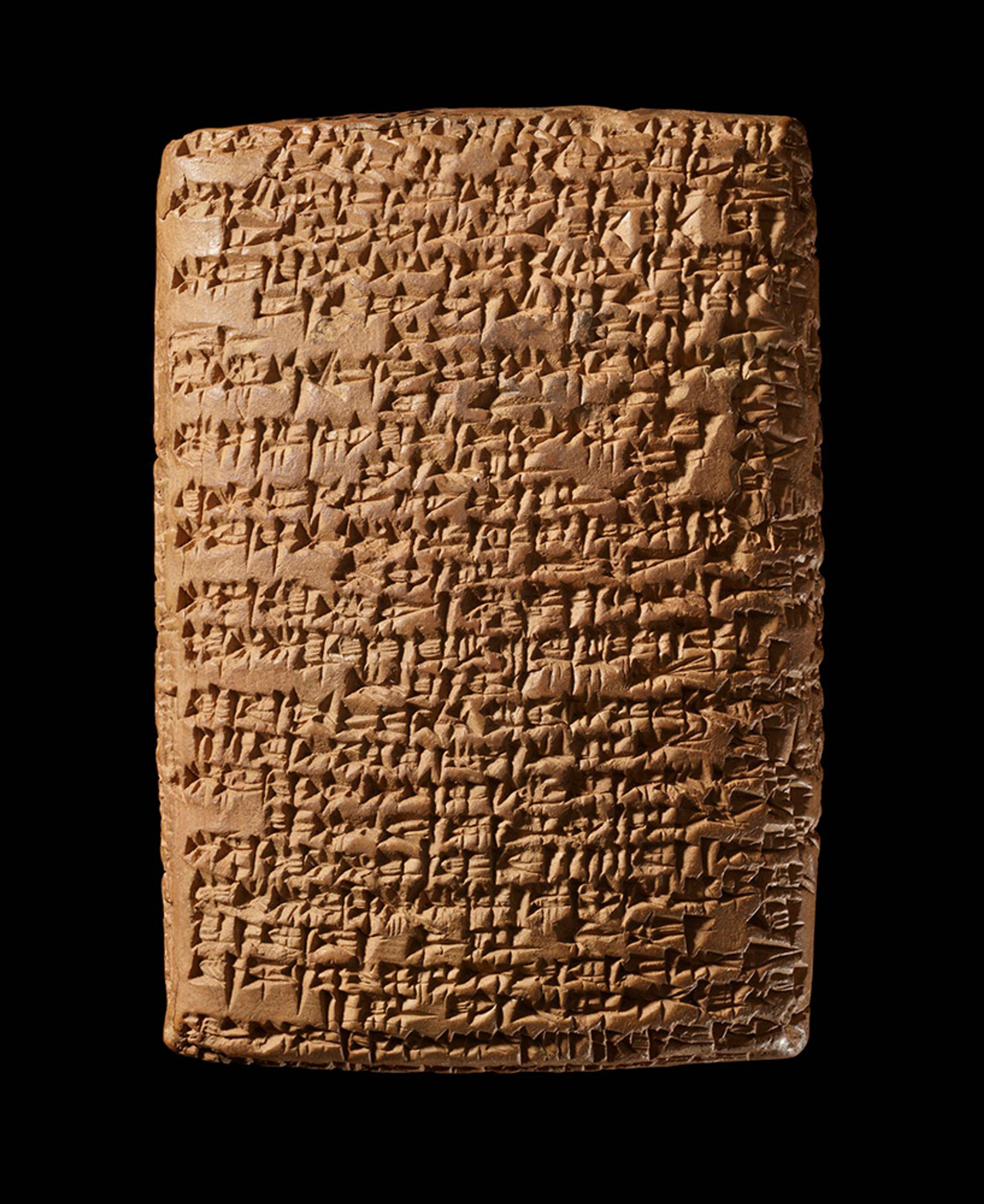
Tablet inscribed with The Hymn to Inana. Courtesy the British Museum, London
Inana is often described as the patron deity of war and love, and that is arguably true. But in Enheduana’s poems, she appears more precisely as the goddess of change. The destruction of war and the passion of love are alike in that they are both powerful forces that overwhelm and transform human lives, and it is this sense of sweep that defines Inana in all her manifestations. To describe the force of this sweep, Enheduana’s poems often recruit metaphors from the natural world, such as storms and wild animals. In ‘The Exaltation’, she is told:
You are like
a flash flood that
gushes down the
mountains …
Meanwhile, ‘The Hymn’ describes her as a hawk that swoops to feed on other gods.
Another common source of metaphors in these poems is war, but this is not war as the playground of heroes that we know from the epic genre. For Enheduana, the battleground is not a place where men may prove their might: humans appear in her poems not as the agents but only as the victims of warfare, as when the poet sings of the soldiers who are led away in chains
while
the wind fills the
squares where they
danced …
War is depicted as an impersonal force that is powered by Inana’s merciless will:
hatches crush heads,
spears eat flesh, and
axes are drenched in
blood …
But the savage warrior who grinds the skulls of her enemies to dust is just one of Inana’s personas. In other texts, she appears as an innocent young girl pining for her lover, the shepherd god Dumuzi. Another of the poems attributed to Enheduana is called ‘The Temple Hymns’, and it is a collection of 42 short odes to the Sumerian gods, temples and cities. Here, we find two hymns to Inana in her sensuous guise, as the goddess of desire and bodily delight, as well as one hymn to Inana in her guise as a terrifying warrior who ‘washes her weapons for battle’.
This split in Inana’s persona is neatly captured in the planet that served as her sign in the skies: Venus. Because it is so close to the Sun, Venus can be seen by the human eye only just before the dawn, when it rises before the Sun on the eastern horizon, and at dusk, when it lingers after the Sun on the western horizon. One cannot follow the planet’s path through the heavens, only observe it in these two opposite positions: east and west, sunrise and sunset. That sense of total contradiction is a perfect astronomical metaphor for Inana’s character.
The hymnic praise of Inana was a venue for thinking about the instability of the Old Akkadian period for two reasons. One was political. Inana was the patron deity of Sargon’s empire, so Enheduana’s devotion to the goddess carries a clear political overtone: in elevating Inana, the poems are also implicitly elevating the imperial regime that Inana was thought to support. The other has to do with the goddess’s character. Just like Inana, the Old Akkadian period came to be associated in Sumerian and Babylonian culture with constant upheavals and change.
Not just in Enheduana’s poems, but across a range of other historical sources, the Old Akkadian period is depicted as a time of legends and larger-than-life drama, not unlike the special place held by the Viking raids or the Golden Age of Piracy in the Western historical imaginary. Sargon and his grandson Naram-Sîn, who succeeded to the throne in 2254 BCE and brought the empire to its zenith, were remembered for millennia as near-mythical figures: Sargon as a paragon of power, Naram-Sîn as a hubristic despot who brought disaster upon his people.
These depictions are often dismissed by modern historians as the mythmaking of later periods, but no one would doubt that the Old Akkadian period was a time of great change. Since the early 3rd millennium BCE, the area that is now southern Iraq had been dotted by dozens of city states, each with its own local deity, dialect and administration, and, though the cities were part of a wider network of trade, conflict and cultural exchange, they remained separate statelets.
The king had to suppress nine uprisings in a single year
Sargon’s army swept through the cities: Kish, Uruk, Eridu, Nippur, Larsa, Umma, Lagash, Girsu, Isin, Eshnunna, Sippar, Eresh, and many more besides. Over the following century, the Old Akkadian kings worked hard to bring the cities into line, suppressing local differences to establish an imperial standard of administration. The nobles who had ruled the cities for centuries were replaced by new elites, drawn from the army and propelled to previously unknown heights of power.
The world must have felt larger than ever before. Soldiers from the flatlands of Iraq made their way into the mountains of Turkey and Iran, traders journeyed as far as Afghanistan to fetch precious stones, and the art of the time shows the influence of Egyptian styles. The ports of Ur would have witnessed the arrival of exciting, exotic wares such as lapis lazuli, ivory, carnelian, cat’s eye, jasper, diorite and serpentine. And these are just the objects that survive in the archaeological record. There were also the foreign foodstuffs, drinks, clothes and perfumes that the citizens of Ur had never seen before. The influx of wealth and materials in turn allowed for major advances in technology and art. The best-known example of both these developments is a bronze statue, traditionally thought to depict Sargon, that vividly displays the sophistication of the court’s artists as well as the technical skill of its smiths.
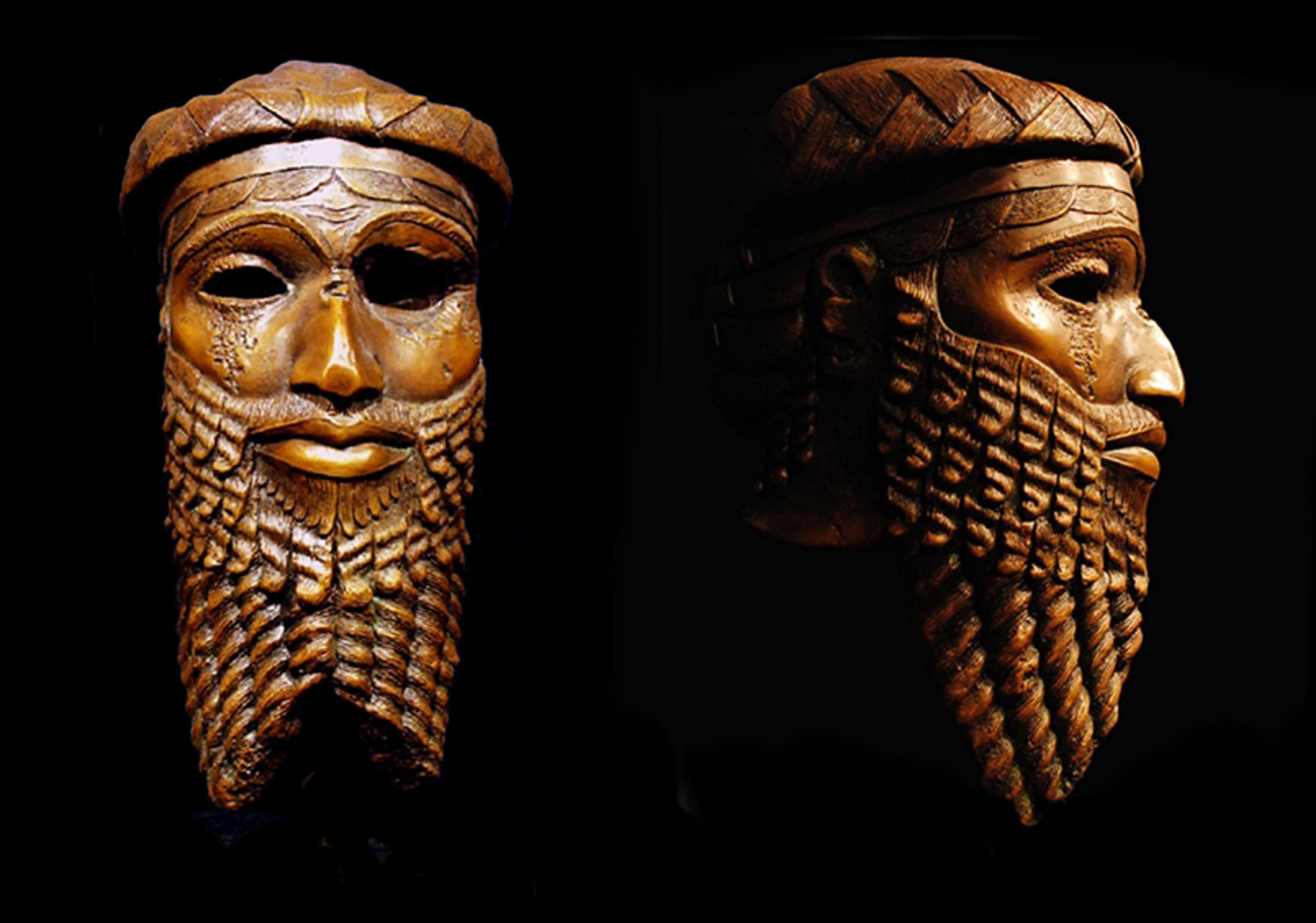
Mask of Sargon of Akkad. From Ninevah, c2250 BCE. Courtesy Wikipedia
The newly empowered especially liked to commission cylinder seals, which were used as a form of personal identification, much like a signature today: one would roll one’s seal over a document to sign it. But the seals also became markers of prestige, as their intricate patterns reflected the status of their owners. The Old Akkadian stonecutters were pushed hard to satisfy their new patrons: the seals of this period are tiny, gorgeous works of sculpture.
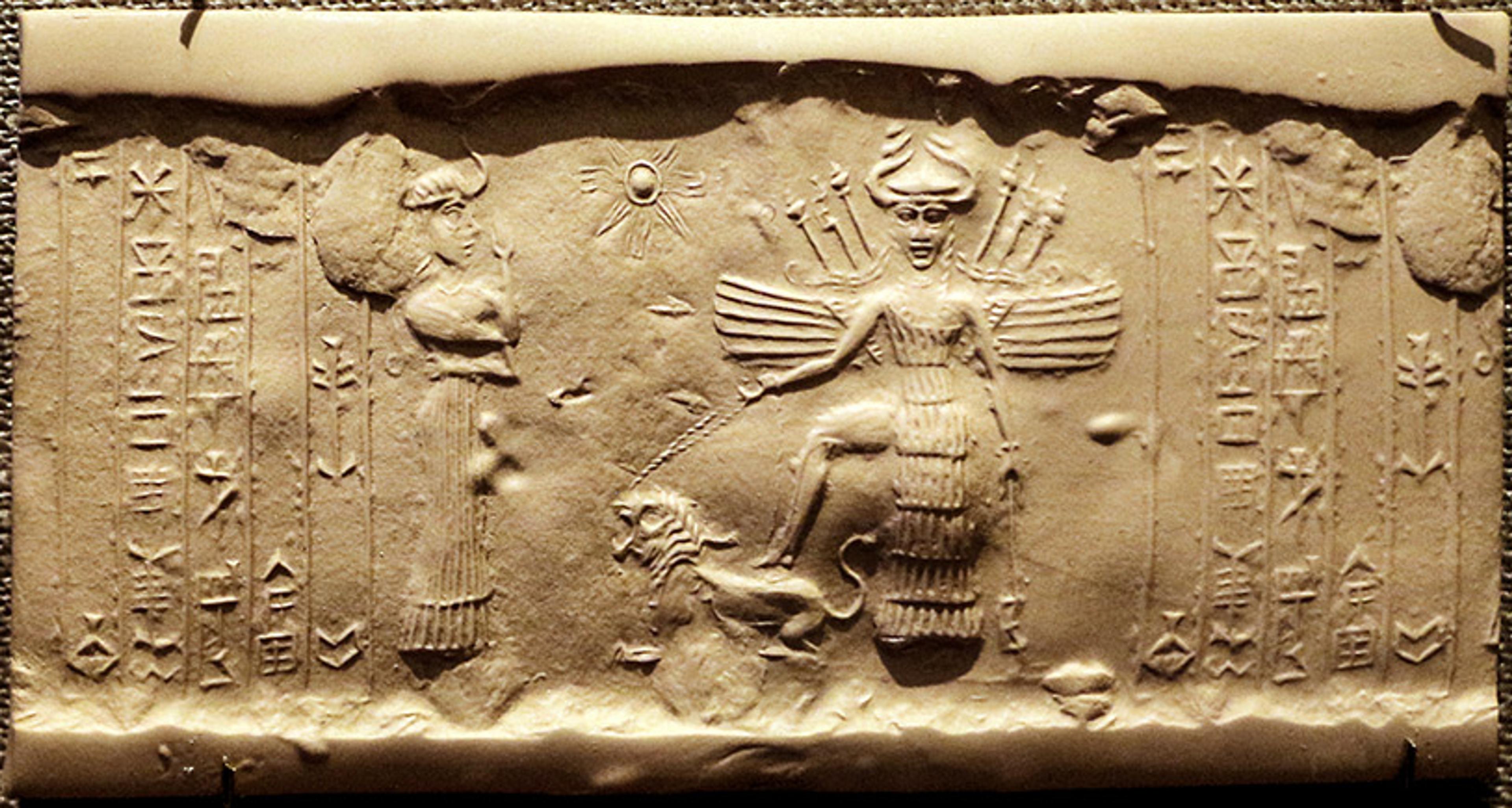
Akkadian cylinder seal depicting the goddess Inana resting her foot on the back of a lion, while Ninshubur stands in front of her paying obeisance, c2350-2150 BCE. Courtesy Wikipedia
But all this power, wealth and artistic expression was tightly concentrated around the king’s court. Dissatisfaction among the old elites was huge, as shown by the constant revolts of the period. This resistance reached a pitch under Naram-Sîn, in what is known as the Great Revolt, when the king had to suppress nine uprisings in a single year. On doing so successfully, Naram-Sîn declared himself a living god – the first king in ancient Near Eastern history to do so. No wonder, then, that he gained a reputation for hubris. Later poets would turn his claim upside down: the story of his nine victories became the story of his nine defeats.
Naram-Sîn’s kingdom also had to contend with a slower, but ultimately deadlier threat. The climate was changing. For reasons that remain unclear to geologists, much of the world went through a severe drought at this time, in what is known as the ‘4.2-kiloyear event’ (that is, an event of uncertain nature that happened 4,200 years ago). Whatever its exact cause, the drought hit especially hard in the Old Akkadian Empire, causing famine and waves of migration.
Eventually, the hard-pressed state could bear no more: under Naram-Sîn’s son Shar-kali-sharri, the Old Akkadian Empire collapsed, leaving behind a complex legacy of legends and changes. It is a perfect metaphor for the period’s place in history that, during this time, the signs of the cuneiform script turned 90 degrees anticlockwise, as they became more abstract and easier to write. Even writing underwent its own literal revolution.
We can only guess at what an average smith in Ur or a shepherd in Akkad felt about the Old Akkadian Empire’s rise and fall. Even for the elites, their lives are most often captured only by brief snapshots, such as the cylinder seals that attest to their existence and little else. That is part of the intrigue that clings to Enheduana’s poems. ‘The Exaltation’ seems to offer a personal account of the political drama of the Old Akkadian period, told by the daughter of the emperor herself. Enheduana was not so much an eyewitness to the insurrection as the eye of its storm.
However, we must bear in mind that the poem is, at best, a literary reworking of a real experience (if it was written by Enheduana herself), and at worst a reconstruction by much later writers of what the rebellion might have been like (if it was written by others in her name). The story of Naram-Sîn’s nine victories that were turned into nine defeats by later poets should remind us that cultural memory is not a reliable guide to what actually happened.
Still, the poems are clearly a literary response to the Old Akkadian period, written either in the thick of it or as a later meditation on its legacy and, as noted, that legacy lasted for centuries. Sargon and Naram-Sîn were still very much alive in Babylonian memory when cuneiform culture died out in the last centuries BCE. That would be enough to make them a fascinating source for understanding this turbulent period, but I would argue that ‘The Exaltation’ and ‘The Hymn’ go on to make the turbulence they are describing the foundation of a specific kind of cosmic insight.
Change, even catastrophic change, was an occasion to see the world more clearly
When faced with social disturbance, one can choose to intellectually suppress it, explaining it away as a momentary aberration of a stable world order, or one can turn it into the foundation for a new worldview. I believe that, in Enheduana’s poems, we see the later strategy pursued with striking insistence: ‘The Exaltation’ and ‘The Hymn’ are dedicated to a goddess whom she portrays as:
… a raging,
rushing flood that
sweeps across the
land and leaves
nothing behind.
In making this claim, I am inspired by the Popol Vuh, the myth of creation of the K’iche’ Mayans, which was put down in writing around the year 1550, in the wake of the arrival of European colonisers that brought the Indigenous populations to the brink of annihilation. In Emergency (2022), his fascinating study of the Popol Vuh, the poet and literary critic Edgar Garcia shows that, rather than offering a resistance to, or a condemnation of, the Western violence, the text seems to do something much more subtle: it folds the experience of colonialism into a cosmic rhythm of crisis and creation, of emergencies leading to the emergence of new possibilities.
The cataclysmic transformation that the Mayan peoples underwent during the 16th century is thus cast as part of a universal principle of repetitions and interruptions that, as far as we can tell from the Popol Vuh, already structured the K’iche’ worldview. Change, even catastrophic change, was not viewed as a conceptual threat that needed to be overcome, but as an occasion to see the world more clearly. And the same is true of Enheduana’s poems.
In elevating Inana, ‘The Hymn’ makes two points. The first is that Inana controls everything around her. This is conveyed by three myths that the poem relays in a miniature format. It tells of how Inana destroyed Ebih, a mountain that failed to pay respect; of how she terrified the god An into sharing his temple with her; and of how she changed the gender of her ritual devotees, turning men into women and women into men. People, gods, even the landscape: all are subject to Inana’s powers of transformation.
The second point is that Inana is subject to no control but her own. As the poem repeatedly stresses, no order can be imposed on her actions:
She overturns what
she has done; nobody
can know her course.
Even her fellow deities have no hope of predicting her decisions:
She confounds the
assembly of the great
gods with her advice,
nobody knows why.
Change emanates outwards from Inana, but she herself remains untouched by the attempts of others to change her.
Having established these two points, ‘The Hymn’ breaks into a long litany that outlines Inana’s contradictory attributes:
To destroy and
to create, to plant
and to pluck out
are yours, Inana
…
To turn brutes
into weaklings
and to make the
powerful puny
are yours, Inana.
To reverse peaks
and plains, to raise
up and to reduce
are yours, Inana
…
To make small or
majestic, weak or
huge, to withhold
and to give freely
are yours, Inana.
To bestow the
rituals of kings
and gods, to obey
and to mislead,
to speak slander,
to lie, to gaud,
and to overstate
are yours, Inana.
The list goes on for some 60 lines, stretching our minds with its length and many contradictions to give us a glimpse of what a divine force of constant change might look like.
‘The Hymn’ and ‘The Exaltation’ seek to elevate Inana to the head of the pantheon, over and above the traditional rulers of the gods, An and Enlil. But, in so doing, they are not just making a point about religion, they are also making a claim about cosmology. If the world is ruled by this kind of goddess, what does that tell us about the world? What would it mean to live in a universe governed by the embodiment of capriciousness, conflict, contradiction, chaos and complexity?
Enheduana’s poems summon a world of radical impermanence, in which nothing around us – neither the mountains on the horizons nor the genders of our own bodies – can be taken for granted. In these poems, confusion is not an intellectual failure to grasp the world, but an appropriate response to the world as it really is: if the figure of Inana should inspire anything in us, it is intellectual humility. The nature of the universe is neither single nor predictable, since the universe is ruled by a goddess who is herself deeply divided and constantly changeable.
Many religions have sought to depict the realm of experience as a changeable surface beyond which lies a transcendent, eternal truth in which we may find comfort. But no such transcendence or mental tranquillity is to be found in the poems attributed to Enheduana. The only truth established in ‘The Hymn’ and ‘The Exaltation’ is that change, as personified by Inana, is supreme. To live in this world, according to Enheduana, is to live with the knowledge that the future may differ radically from the present, just as the present of the Old Akkadian period differed radically from its past.
This vision of the world may seem a far cry from how we mostly make sense of it in our modern age. Academics of all stripes are united in their search for regularities that help explain the world we see around us, from chemical laws through psychological patterns to social systems such as capitalism or the patriarchy. In other words, when we try to understand a given phenomenon today, we most often do so by exploring the structures that shape it, meaning that the change and confusion embodied by Inana can seem like a rather naive way of explaining the world.
But there are signs that our increasingly changeable times are being met with an increasing interest in change as a strategy for understanding the world. In their book Impermanence (2022), a team of British, Danish and Australian anthropologists promote what they see as an emergent theory of flux within the social sciences. This budding body of research draws inspiration from non-Western philosophies such as Buddhism – which has reflected on the significance of change and radical impermanence for millennia – to reframe familiar topics within anthropology and sociology.
The question that propels that book, and the academic movement behind it, can be summarised as follows: how does a focus on change affect our perception of our objects of enquiry? Do social phenomena (the book explores examples such as migration, museums and alcoholism) look different when they are seen as being in a continuous state of flux rather than as determined by semi-static social structures?
How does one stay sane at a time like this? How does one live at a time like this?
Of course, one swallow does not make an academic summer. But, even in popular culture, one can detect a rising interest in philosophies that explicitly base their worldview on constant change. A key example is Stoicism, which promotes detachment and equanimity in the face of a world that it sees as inconstant and chaotic. According to Google Trends and Google Ngram – which track the mentions of a given word in, respectively, Google searches and texts uploaded to Google Books – interest in Stoicism is on a steady rise, which may signal that people around the world feel a growing need for intellectual guides to turbulent times.
And who can blame them? I grew up in what now seems like a historical bubble of relative calm. The Western world around the turn of the millennium was sufficiently free from war, ideological conflicts and global pandemics for pundits to speak confidently of a lasting world order. Francis Fukuyama declared ‘the end of history’ and, while I was painfully aware of the injustices that plagued much of the globe, my corner of it, at least, felt safe.
Now, having just turned 30, I confront a very different reality. Before me, before us, lie the catastrophes of the climate crisis and the social upheavals required to reduce emissions and adjust to extreme weather. Then there is COVID-19, which is unlikely to be the last global pandemic of this century, as no serious measures were put in place to prevent a recurrence of similar diseases. Then there is the war in Ukraine, and the economic turbulence it has brought; and the ongoing divisions that plague Western democracies and seem to grow deeper with each passing year. And so on. The list is familiar, almost clichéd, but each entry in it contains real horror.
By the end of my lifetime, the world is overwhelmingly likely to look even more unstable than it does today. Collectively, we will have gone through a period of transformation that is all but unmatched in human history. I do not know how to feel about that, because it is not the sort of thing I was raised to feel any way about. How does one stay sane at a time like this? How does one live at a time like this?
Enheduana does not offer clear answers to these questions, and I would not hold her up as a model for good living in difficult times. But her poems fascinate me in part because they describe, with dazzling intensity, a world where change is the norm. These are poems from, and about, unstable times. That is one reason I am drawn to them: I want to understand what it means to live in such a world, because I will probably have to.
